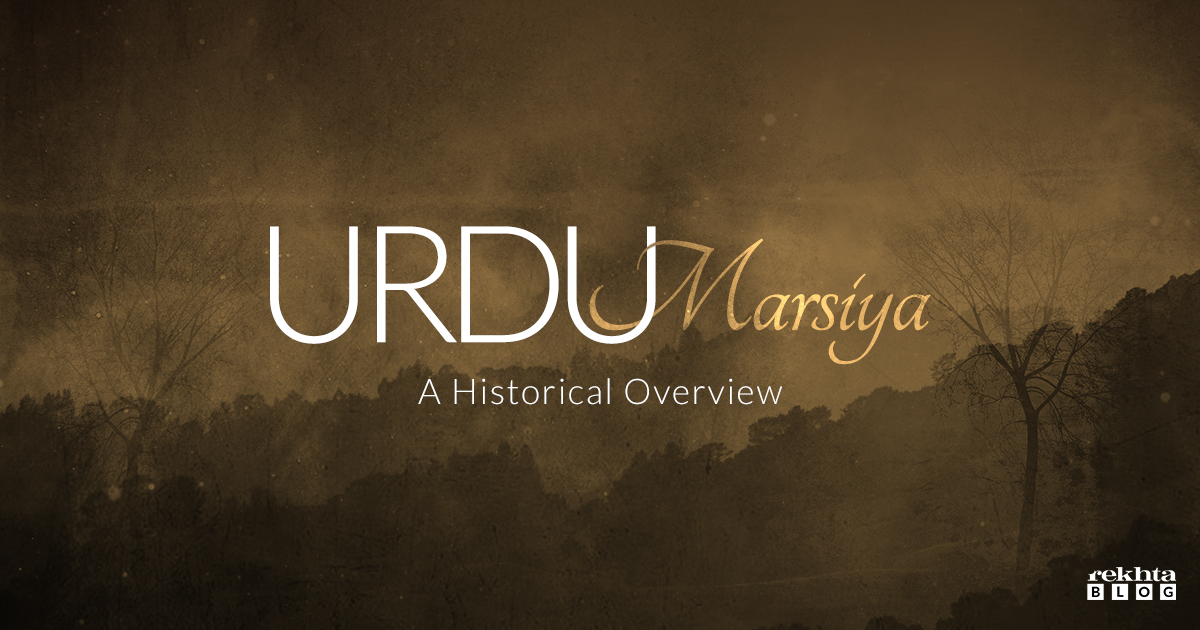
Urdu Marsiya: A Historical Overview
The term ‘Marsiya’ (elegy) is derived from Arabic word ‘risa’ which means lamentation of the dead person, weeping and wailing over the deceased. It existed in Iran as a well defined literary form, in pre-Islamic days. ‘Sog-e-Siyahwashan’ (mourning of Siyahwash, father of Kai Cyrus), ‘Marg-i-Zarir’ (the death of Zarir, brother of Gushtasp) and some others are still considered as legacy of ancient Persian literature. Despite of having roots in Persian literary tradition, it acquired its own uniqueness in Urdu literature in 19th century. Marsiyas in Urdu were first written in the kingdoms of Goloconda and Bijapur, which were ‘Shiite’ in orientation and closer to Iranian tradition. It developed in the Deccan as a form of folk poetry, initially with its own roots, and independent of Persian tradition afterwards.
The first poet to write ‘Urdu Marsiya’ is probably Ashraf or Quli Qutub Shah which is still a matter of debate; however it underwent major changes in its form, style and subject during these years. Marsiya as we know it today with its thematic beauty, invariably in the form of ‘Musaddas’ and having conspicuous narrative continuity developed in 19th century Lucknow, with its ‘Shiite’ state, contributing most to its development. Mir Anis and Mirza Dabeer took this genre to the zenith of success and it developed its own traditional and cultural values very soon.
Deccan Phase: Bahmani Sultanate, established by Ala-ud-din Bahman, after revolting against Mohammad Bin Tughlaq in 1347, is accounted as first independent Muslim kingdom in South India, and one of the major medieval India kingdoms. Based upon the medieval chronicles of ‘Mohammad Qasim Farishta’ and Syed Ali Tabatabai it is believed that Sultanate practiced ‘Shiya Islam’ and rulers of the dynasty were patrons of the Persian language, culture and literature. Mentions of famous marsiya poet ‘Aazari’ is found in ‘Haft Aqleem’ and ‘Khazana-e-Aamarah’ during this period. One of his couplets quoted in ‘Haft Aqleem’ is:
“Soorakh mee shuad dil-e-maachoon gham-e-Hussain;
Har jaa ke zikr-e-waaqia-e-karbalaa buad”
Abu Al Nasr Khalidi states that some of the members of dynasty themselves became well versed in Persian and started composing literature in this language. He quotes one of the couplets from Munajat (supplication attributed to Ali ibn Abu Talib) written by last Bahmani King Mahmood Shah:
“Dar bahr gham fanaa dam o amwaaj be adad;
Taa chand dast o paa zoam o yaa Ali madad”
Lucknow Phase: Under Shuja-ud-Daula’s reign Faizabad developed into a hub for art and literature, and started attracting writers, artists and courtesans from all over Europe and Asia. After the death of Shuja-ud-Daula when capital was moved from Faizabad to Lucknow by his son Asaf-ud-Daula in 1775, a caravan of Marsiya writers followed him which included Mirza Panah Beg ‘Afsurdah’, Miyan Qalandar Bakhsh ‘Jur’at’, Mir Hasan, Ashraf Ali Khan, Mir Mohammad Ali ‘Sabr’ and many more notable names. Sauda started writing Marsiyas in Faizabad itself. Some studies suggest that it was Sauda who started writing Marsiya in Musaddas form and slowly over a century or so, the ‘Musaddas’ came to be regarded as the most suitable form for a Marsiya.
Mir Anis and Mirza Dabeer, are considered as pioneers of Marsiya, and in mid 19th century these two poets completely transformed this genre making it much more multi-dimensional. These two poets laid the foundation of new Marsiya in 19th century and established what came to be known as fundamental characteristics of good Marsiya. They put much careful thoughts in organization of verses and they developed depiction of indigenous socio-cultural values and practices in Marsiyas. The heroes and heroines are Arabs but they behave like the Muslim upper classes of Lucknow, and their customs, values, marriages and family relationships were all Indian. The Indianness in descriptions and details brings those events closer to the Indian audience and makes it easier to identify with the martyrs. They introduced certain elements that a Marsiya contains, and each marsiya had all or some of the following subsections based on the theme:
• Chehra : a prologue of praise, which could have praise of God, the prophet, Ali, Hussain or the praise of poet himself
• Majrah : event or incident introducing the protagonist
• Sarapa : detailed description of physical and spiritual qualities of protagonist
• Rukhsat : departure of protagonist for battlefield (Karbala)
• Rajaz : the declaration of his noble ancestry and personal virtues by the protagonist
• Jung : description of the battle (Battle of Karbala)
• Shahadat : death of protagonist in battle field
• Bain : lamentation
• Dua : pious sentiments of poet himself
These two poets with their use of scenography, use of extended metaphors and conceits and use of traditional rhetoric language for their own purposes made Marsiya a closest thing to epic in spirit. They expanded the dramatic potential of characterization, plot, language and genre. One bandh from a Marsiya, written by Mir Anis is as follows:
“Thandi thandi wo hawaaen wo bayaabaan wo sahar
Dam-ba-dam jhoomte the vajd ke aalam me shajar
Os ne farsh-e-zamarrud pe bichhaae the guhar
Lauti jaati thi lahakte hue sabze pe naza
Dasht se jhoom ke jab baad-e-saba aati thi
Saaf ghunchon ke chatakne ki sadaa aati thi”
Hali also wrote Marsiyas, and one of his famous Shakhsi Marsiya commemorating the death of Mirza Ghalib is considered noteworthy. Josh Malihabadi, Ali Sardar Jafri, Faiz Ahmed Faiz, and many others from Progressive Writers Movement have also written Marsiyas. Drawing inspiration from Progressive Writers Movement and its vision of ‘Inquilab’ Josh tried to inspire his contemporaries to make a breakaway from classical tradition and write in the context of present times. One ‘bandh’ from his famous marsiya ‘Hussain aur Inquilab’ is as follows:
“Amraaz hai kisi ka budhapa hai ik vabaal
Aalaam hai kisi ki jawani hai paayemaal
Is ko khauf-e-nang use naam ka khayal
Rozi se koi tang koi ishq se nidhaal
Har saans hai naveed azaab e azeem ki
Ghabra ke do duhaii khuda-e-raheem ki”
Despite being such an important genre which had strong hold on cultural, social and literary milieu, the art of Marsiya writing has seen a gradual decline. After Anis and Dabir, Marsiya could not survive for long period as compared to other genres of Urdu poetry like Ghazal and Rubai. Some of the important developments in the field during 20th century that developed in the form of nazm has completely been ignored and kept aside. However, some of the important contemporary Urdu poets like Iftikhar Arif, Akhtar Usman and many others have also written Marsiyas. Development of a new tradition of writing marsiya in modern verse is chiefly represented by Iftikhar Arif.
NEWSLETTER
Enter your email address to follow this blog and receive notification of new posts.




